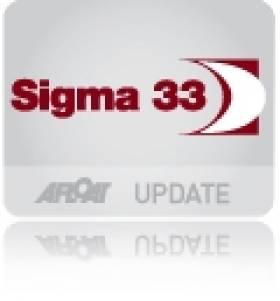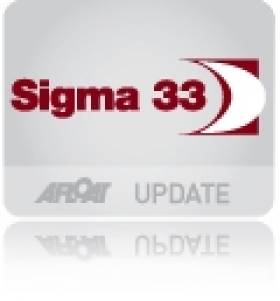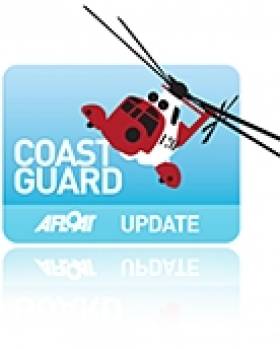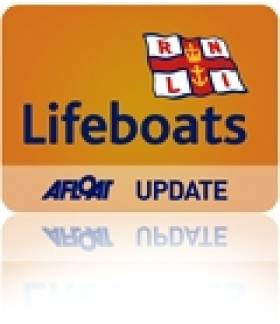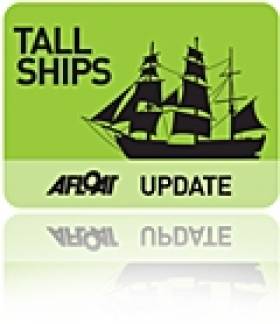Displaying items by tag: Belfast
Take Your Seats for the Belfast 'Dockers'
Laced with whiskey, wit and ballsy humour, Dockers is a very Northern Irish play with a universal message. Working class hero John Graham struggles to bring equality and integrity to the brutal working environment of the Belfast docks.
As one man's idealism confronts the tribal politics of the docks, a sobering and shocking turn of events brings the play to a climactic ending. Lynch's critically acclaimed and popular play was first produced by the Lyric in 1981. For further information click HERE
‘Bounty’ Joins Belfast’s Titanic Maritime Festival
The US-flagged replica tallship H.M.S. Bounty arrived into Belfast Lough this morning for the Belfast Titanic Maritime Festival (24-26 June), writes Jehan Ashmore.
Measuring some 200 tonnes, the three masted-replica ship of the original H.M.A.V Bounty where the famous mutiny against Captain William Bligh took place in Tahiti in 1789, is to open to the public.
The replica was constructed in Nova Scotia of the original Hull-built vessel for the 1962 MGM film 'Mutiny on the Bounty' starring Hollywood screen legend Marlon Brando.
The Bounty was also used in the filming of Pirates of the Caribbean II and a Lone Wolf Production Group documentary on Blackbeard and has featured in several documentaries.
'Bounty' will be open to visitors (for information www.tallshipbounty.org) and is to be accompanied by the Jubilee Sailing Trust's Lord Nelson (www.jst.org.uk/).
The festival venue is at the Queen's Quay, Abercorn Basin and Arc, behind the Premier Inn Hotel at the Titanic Quarter.
As for the Titanic, tours of the old main offices of the H&W shipyard on the Queen's Road courtesy of the Titanic Quarter Ltd will be open to the public with displays relating to Titanic and Edwardian Fashion.
In addition Titanic Bus Tours lasting two hours which are free are available from the Belfast Welcome Centre, to contact Tel: 028 9024 6609.
For a complete listing of the festival events, dates and opening hours go to www.belfastcity.gov.uk/maritimefestival/index.asp
- Belfast
- Port of Belfast
- Lord Nelson
- Belfast Lough
- Titanic
- Jubilee Sailing Trust
- Titanic Quarter
- Belfast Harbour Commissioners
- Tahiti
- Harland & Wolff
- Belfast Lough News
- MGM
- Hollywood
- Maritime Festivals
- Mutiny on the Bounty
- Captain William Bligh
- Marlon Brando
- H.M.S. Bounty
- H.M.A.V. Bounty
- The Bounty
- MGM Film Studies
- Replica tallship
- Maritime Events
- SS Titanic
- H&W
- JST
- Holiday Inn
- Queen's Quay
- Abercorn Basin
- Titanic Quarter Ltd
- Belfast Welcome Centre
White Mischief Wins Sigma 33 Title Again
The Hamilton Shipping sponsored event was scheduled over three days but Friday's 37 knot winds put paid to racing that day. However Principal Race Officer Robin Gray's efforts on the Saturday produced five races then and another three on Sunday, making a substantial championship race programme.
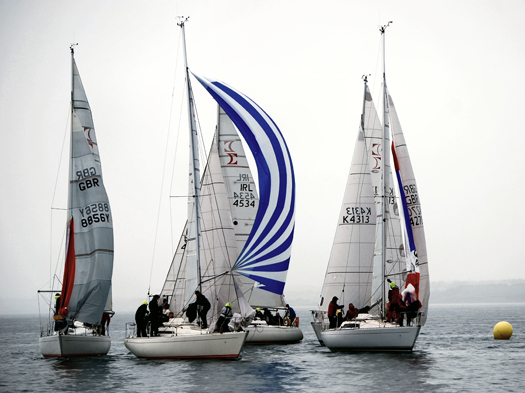
The seventeen strong fleet came from Scotland, Dublin Bay, the Isle of Man, Belfast Lough and Strangford Lough.
Proving that consistency as well as speed pays, Goodbody won only one race but counted scores never over 4th, giving White Mischief a total of 19, seven ahead of runner up, newcomer Stephen Milne and the team on the borrowed Cushendall based Insider. Milne is a member of the Skandia Team GBR Performance Squad as crew for John Gimson in a Star.
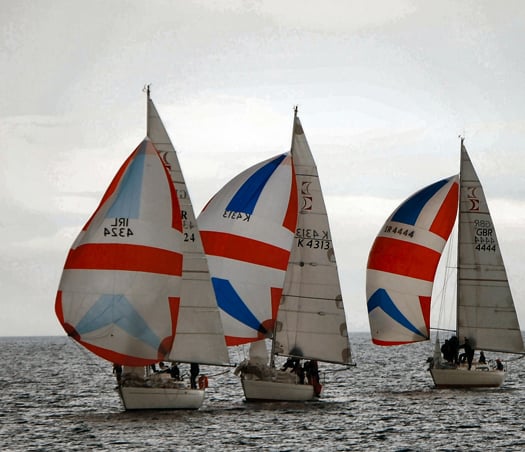
The first and fifth races went to the Scottish boat, Mayrise (James Millar) but a disqualification in Race 7 dropped her from starting third overall on the Sunday to a 6th place finish. Ross Boyd's Mithril from Quoile won Races 2 and 4 and the other Strangford Lough entry, Signet of Kip made up for a disqualification in Race 2 by winning Races 3 and 8. Goodbody took first in Race 7.
At the prize giving Hamilton Shipping's Finance Director Ken Craig admitted that he knew nothing about sailing but was impressed by this competition.

He couldn't be 69!

Hamilton Shipping Finance Director Ken Craig and his wife Tricia with RUYC Rear Commodore Stephen Graham and the crew of White Mischief. Photos by Ken Hunter
Sigma 33s Bound for Belfast Lough
The event, sponsored by Hamilton Shipping, has already attracted yachts from Scotland, Dublin Bay, Isle of Man and Strangford Lough and they will join the locals for eleven races over the three days. Seventeen have entered.
Among the entries is the current champion, Tim Goodbody in White Mischief from the Royal Irish at Dun Laoghaire as well as five boats who took part in the recent Scottish Series including the class winner Donald McLaren in Sigmatic.
Locals gearing up for the competition are great rivals, Blues (Hamilton/Milne) and the Taylor/Sherwood team in Sula as well as Gerry Bell’s Cariad and Chris and Michael Johnston’s Impulz.
Belfast Firm's Big Takeover of Global Marine Business
A Belfast-based company has taken over a global marine business in a £31 million (€35.7 million) deal, the Belfast Telegraph reports.
Survitec Group Limited, based in Dunmurry, has acquired Cosalt Marine, a worldwide supplier of liferafts, lifejackets and survival suits with clients such as the RNLI and P&O Ferries.
Cosalt joins an already bustling portfolio of brands in the Survitec Group, including DSB and Beaufort, as the rebranded Survitec Service and Distribution Ltd.
The company's 450 staff will join the more than 1,000 already employed by Survitec, which operates across the UK and Europe.
The Belfast Telegraph has more on the story HERE.
Titanic Artifacts Surface at New Exhibition
Relics from the Titanic will get their first public airing at an exhibition in Co Down this month.
The Newsletter reports that the new display at Cultra's Folk and Transport Museum - which will be opened on 31 May - comprises 35 items from the doomed ship, including part of the hull, silver and glassware and a number of personal items.
"Nothing tells the story of Titanic more poignantly and dramatically than these artifacts," said Alexandra Klingelhofer of RMS Titanic Ltd, which has loaned the items to the museum.
The new exhibition marks 100 years since the launch of the Titanic from the Harland and Wolff shipyards in Belfast.
Missing Surfers Found in Cave
Coastguard and Lifeboat services were pressed in to action early this morning to search for missing surfers on the North Coast.
At 02.20 am MRCC Belfast received a call from Police Service Northern Ireland reporting that they had received a call from a lady reporting that her son had not returned from a surfing trip with a colleague.
They had gone surfing at 6.00 pm yesterday evening and were due to return at 11.30 pm.
Belfast immediately called out the Coleraine Coastguard rescue team and requested the launch of the Portrush RNLI lifeboat and inshore lifeboat. The Coastguard helicopter R118 from Sligo, Ireland was also scrambled. PSNI officers with dogs were also assisting in the search.
A search was initiated based on the location of their car which was located at Whiterocks car park containing their personal items and their board covers.
At 3.45 am this morning, the two surfers emerged from a cave. They had gone surfing when one of the surfers sustained a head injury when thrown onto the rocks by the waves. They went into a cave to shelter. They think had been there 6 hours could not get out due to the waves. They were waiting until waves subsided, saw the boat and came out of the cave when a little shore line appeared. The men then went onto the road and met the Coastguard search team.
Liam Colquhoun, Watch Manager Belfast said:
We are pleased that the two men have been located. They have declined any medical treatment and have gone home.
The two men had done the correct thing in making sure that a shore contact knew when they were due to return from undertaking their activity.
If you see someone in trouble at sea or on the coast, Dial 999 and ask for the Coastguard.
11 Kayakers Rescued by Portrush Lifeboat
The callers stated that they could see a group of twelve kayakers in difficulty off Portballintrae, Causeway Coast, Northern Ireland.
Belfast Coastguard called out the Coleraine Coastguard Rescue Team and requested the launch of the Portrush RNLI lifeboats.
On arrival the Coleraine Coastguard Rescue team kept the kayakers under observation and directed the Portrush RNLI inshore lifeboat to the Kayakers. It was quickly established some of the group had become exhausted and suffering from sea sickness. Eleven of the group where transferred onto the large all weather Portrush Lifeboat whilst the Inshore Lifeboat escorted the one remaining kayaker back to Portballintrae Harbour.
The Portrush Lifeboat then transferred the eleven rescued kayakers who were mainly teenagers to the safety of Portrush Harbour.
Luckily none of the group required any medical attention.
Portrush lifeboat station adds:
Weather conditions were blustery and there was quite a swell off the coast. There was a North West wind coupled with a strong ebb tide. The tide was flowing against the wind, making conditions for the kayakers extremely difficult to return to shore. The Inshore Lifeboat (ILB) was launched first but it became clear the All-weather Lifeboat (ALB) was going to be needed to assist with the recovery of the party.
The ILB recovered 3 kayakers and returned them to Portballintrae. The ALB recovered the rest of the party and took them to Portrush Harbour.
The kayakers are safe and well, apart from suffering chronic sea sickness
Robin Cardwell Lifeboat Operations Manager said
'The fast response of the volunteer RNLI Lifeboat Crews from Portrush Station undoubtedly saved the lives of these kayakers. The sea and wind conditions made it virtually impossible for them to return to shore. Without the fast response of the crews at Portrush, this would have had a very different outcome'
Last of National Rowing Heads takes place in Belfast Today
There are 148 crews over the three races starting with pairs and sculls, then doubles and fours and finishing in the afternoon with eights and quads. The third race features 35 eights and 26 quads.
The big race of the day, the men's senior eights, which starts at 3.45 pm, will feature a high intensity race between the two Queen's University eights. The A Queen's crew, with new strokeman, Mike Ewing, have been relatively the same crew for the last three years. This is the crew which mounted serious challenges to the victorious NUIG team at the Irish Rowing Championships, narrowly missing out on a national senior eight by a mere few feet on two occasions. The A team's Ewing won a Wyfold cup (men's coxless four) at Henley last year.
The women's intermediate eights should prove interesting with a crew entered from St Andrews in Scotland who will be up against Queen's University Ladies and St Michael's, Limerick.
The men's junior 16 eights sees all the Ulster crews up against each other whilst the men's junior 18 quads sees Blackrock College, Dublin, Shandon ,Limerick and Offaly Rowing Club take on the Ulster schools.
Eight crews will contest the men's Master's pennant (over 28s) with Galway, Bann and Athlone pushing the Belfast-based masters crews, Belfast Boat Club, Belfast Rowing Club and the Lady Victoria Boat Club, all the way. The former Queen's ladies rower ,Frenchwoman Solange Garrais is bringing a men's Masters and a women's Masters quad from Aviron Grenoblois, France to compete.
The 10.45 am and 13.15 pm races start at the Albert Bridge in Belfast and finish at Queen's boathouse at Stranmillis. The 15.45 pm race starts at the Odyssey building in Belfast Harbour and finishes at Queen's boathouse at Stranmillis. There are viewing points along the full length of each race.
The official start to the regatta season takes place on Saturday 2nd April with the Neptune regatta at Islandbridge, Dublin.
Click this link for Irish Rowing detailsClick this link for the Latest Rowing News
Tall Order for Ireland
Sailing in Ireland could yet have a tall ship to replace the Asgard II and the Lord Rank. A meeting in Dublin in late March represents a major step forward in the process to put an Irish tall ship back on the high seas.
The open workshop, to be held on March 26th, will be facilitated by Dublin Port, and will include state interests, tourism interests, commercial port interests, youth organisations, maritime organisations and education groups, together with the former Lord Rank and Asgard II operators.
The catalyst for the initiative is a 'reference group' which represents a broad cross-section of interests, both North and South. Operating under the chairmanship of Lord Glentoran, and supported by Dr Gerard O'Hare, David Beattie and Enda O'Coineen, the group has also engaged a professional consulting firm to move the process along.
The initial focus is on the necessary organisation and rationale behind building a new vessel, while scientifically quantifying the benefits to build a plan and justification.
The view taken is that, while there may be no money available at this time, there is no excuse for not having a plan and the idea is to create ' joined-up' thinking. And while the government in the South placed the insurance money paid out on Asgard II back into general exchequer funds, the insurance payment on the Lord Rank was kept and ' ring-fenced' for this new initiative.
To date, there have been several meetings of the reference group. The planned workshop on the subject at Dublin Port March 26 is open and interested parties are invited to contribute. It will also bring together for the first time the leaders of Tallships in Dublin, Belfast, Waterford and Cork.
Ultimately Tall Ships is about youth training and development; without an active Tall Ship, it will be very difficult for Ireland to attract Tall Ship events. The new reference group will work to support the new Sail Training Ireland Association initiative, and link in with Sail Training International which runs Tall Ship events.
Following the Dublin workshop, Belfast Harbour Commissioners will host a working meeting of the group in early May to finalise a plan, present to stakeholders and create a roadmap forward.
"In addition to youth training, a working Tall Ship forms a brilliant ambassadorial role promoting tourism, enterprise and commercial interests," said Lord Glentoran. "It is something that we can all relate to and it has universal acceptance for youth training on an island of Ireland basis." Lord Glentoran has a long commitment to youth sail training and was Chairman of the organising committee that brought the Tall Ships to Belfast in 1991.
The reference group is seeking to engage with as many stakeholders as possible, and has pledged that the new vessel will be owned by the community in Ireland and the Irish Diaspora. The initial view is that the project clearly needs to be linked with the institutions of State - North and South - as are universities state agencies and ports, while at the same time having a strong private support network making for a mix of public and private funding, "We now have a brilliant opportunity to look around the world, establish best practice in the best kind of vessel, how to fund it and to quantify the benefits for each of the stakeholder group," said Enda O'Coineen, who has been instrumental in bringing the group together. In addition to being a former Coiste and Asgard Director, he is the founding Chairman of Let's Do It Global, which brought the Volvo Ocean Race to Galway and successfully raced the Green Dragon around the world.
O'Coineen added that a "world class solution" can be created and that its benefits can be financially quantified, which would allow supporters to make a compelling business case to divert and use existing funds in Tourism, Enterprise and Youth Training. "While there is no money available now to support the scale and professionalism needed, this is not an excuse not to have a plan and a vision," he added.
Since the loss of the Asgard II and Lord Rank, Ireland has been left with no sail training opportunities for young people and likewise for maritime development, enterprise and tourism. If nothing is done, future generations will suffer. The reference group believes that the solution is the construction of an Ireland - North and South - training vessel, fulfilling several roles with a common mission and resourced according to quantifiable benefits delivered to stakeholders. It is also open to the use of an existing vessel - a key component being suitability and the operations budget.
The proposed Tall Ship project will enhance skills and opportunities for young people across the island, regardless of background, class or education. It could be used to showcase Ireland as a brand at overseas events and it could also host international students who wish to come to the island of Ireland, as is the case with many of the International Tall Ships Programmes already running on a global scale which create a huge amount of tourism for their respective countries.
The reference group notes that the Tall Ships concept appeals to young and old alike as the romanticism behind the concept touches on history, social studies, legacy, family, travel, adventure and, most importantly, fun. Tall Ships allow people to dream. They do however have an underlying seriousness and the concept is grounded in methodology that has been tested and proven the world over.
An advertisement in March/April of Afloat magazine - out now - gives full detials of the 'Tall Ship for Ireland' Workshop
Should Ireland be represented at the Tall Ships Races at Waterford 2011 and Dublin 2012? We want your vote on our Facebook Poll HERE.
Looking for further reading on Tall Ships in Ireland? Click the links below:
Click this link to read all our Tall Ships Stories on one handy page
Previewing Ireland's Tall Ships 2011 Season






























